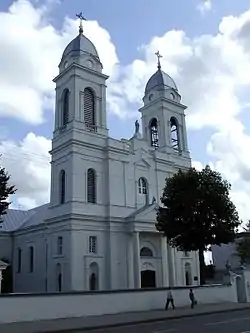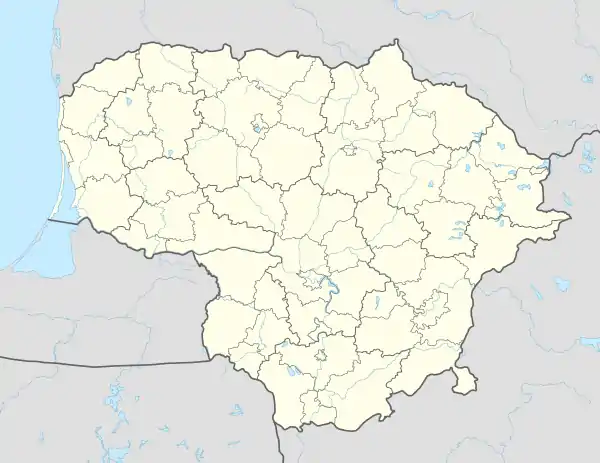Garliava
Garliava (ⓘ), is a city in Kaunas District Municipality, Lithuania. Garliava is located 10 km (6.2 mi) south from the center of Kaunas and has a territory of 3,65 km2.
Garliava | |
|---|---|
City | |
 Church of Holy Trinity in Garliava | |
 Coat of arms | |
 Garliava Location of Garliava | |
| Coordinates: 54°49′0″N 23°52′0″E | |
| Country | |
| Ethnographic region | Suvalkija |
| County | |
| Municipality | Kaunas district municipality |
| Eldership | Garliava eldership |
| Capital of | Garliava eldership Garliava rural eldership |
| First mentioned | 1809 |
| Granted city rights | 1958 |
| Population (2022) | |
| • Total | 10,234 |
| Time zone | UTC+2 (EET) |
| • Summer (DST) | UTC+3 (EEST) |
Name

Garliava is the Lithuanian name of the city. Versions of the name in other languages include Polish: Godlewo, Russian: Годлево Godlevo, Belarusian: Гадле́ва Gadleva, Yiddish: גודלעווע Gudleve, Latvian: Garļava.
History
In 1809 Józef Godlewski built a Holy Trinity church and named the settlement Godlewo in his own honour, although Lithuanians started calling it Garliava. This year is generally viewed as the year Garliava was founded. It lay along a significant postal route between Saint Petersburg, Kaunas, Marijampolė, and Warsaw.
Godlewski also built a place of worship for Lutherans and a synagogue for Jews.
Notable residents

- Józef Godlewski (1773–1867), founder
- Jonas Algimantas Boruta (1944-2022), Roman Catholic prelate
- Juozas Gabrys (1880 – 1951), politician and advocate of Lithuanian independence, was born in Garliava. In his memoirs, he referred to himself as the "Count of Garliava."
- Darius Labanauskas (*1976), darts player
Education
There are five schools: Garliavos Juozo Lukšos gymnasium, Garliavos Jonučių high school, Garliava high school, Kindergarten and primary school of Garliava, and Garliava school of arts and music.
References
- (in Lithuanian) History of Garliava. Eldership of Garliava.
External links
- (in Polish) Godlewo in the Geographical Dictionary of the Kingdom of Poland (1881); the first entry "Godlewo", item 3.) within

